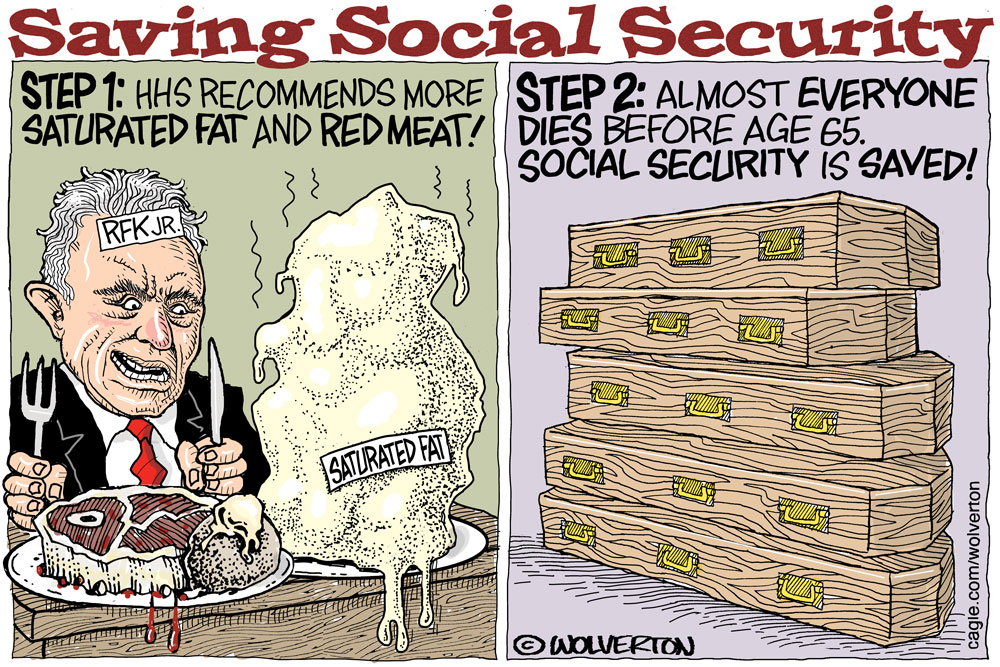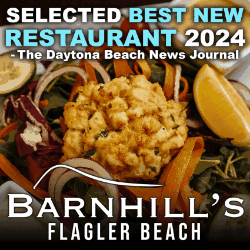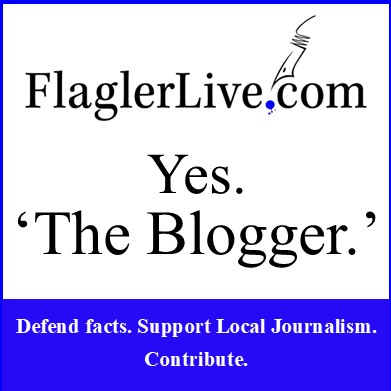
To include your event in the Briefing and Live Calendar, please fill out this form.
Weather: A 30 percent chance of showers after 2pm. Mostly sunny, with a high near 80. Breezy. Sunday Night: A 30 percent chance of showers. Mostly cloudy, with a low around 69.
- Daily weather briefing from the National Weather Service in Jacksonville here.
- Drought conditions here. (What is the Keetch-Byram drought index?).
- Check today’s tides in Daytona Beach (a few minutes off from Flagler Beach) here.
- Tropical cyclone activity here, and even more details here.
Today at a Glance:
Palm Coast Farmers’ Market at European Village: The city’s only farmers’ market is open every Sunday from noon to 4 p.m. at European Village, 101 Palm Harbor Pkwy, Palm Coast. With fruit, veggies, other goodies and live music. For Vendor Information email [email protected]
Thornton Wilder’s ‘Our Town,’ at Limelight Theatre in St. Augustine, 11 Old Mission Avenue, St. Augustine. 7:30 p.m. except Sundays, at 2 p.m., and on Nov. 15. Thornton Wilder’s timeless masterpiece chat quietly and powerfully explores life, love, and loss in small-town America. A deeply human story that resonates with every audience.
‘The 39 Steps,’ at the Daytona Playhouse, 100 Jessamine Blvd., Daytona Beach. Box office: (386) 255-2431. 2 p.m. Adults, $25, seniors, $24, Youth, $15. Book here. Mix a Hitchcock masterpiece with a juicy spy novel, add a dash of Monty Python and you have The 39 Steps: a fast-paced whodunit, with over 150 zany characters (played by a cast of only four), an onstage plane crash, handcuffs, missing fingers, and some good old-fashioned romance! Content advisory: Fake guns and gunshot sound effects
Gamble Jam: Musicians of all ages can bring instruments and chairs and join in the jam session, 2 to 4 p.m. Note that in a temporary change from the regular schedule, Gamble Jam will be the 2nd and 4th Sunday of each month through August 17. The program is free with park admission! Gamble Rogers Memorial State Recreation Area at Flagler Beach, 3100 S. Oceanshore Blvd., Flagler Beach, FL. Call the Ranger Station at (386) 517-2086 for more information. The park hosts this acoustic jam session at one of the pavilions along the river to honor the memory of James Gamble Rogers IV, the Florida folk musician who lost his life in 1991 while trying to rescue a swimmer in the rough surf.
ESL Bible Studies for Intermediate and Advanced Students: 9:30 to 10:25 a.m. at Grace Presbyterian Church, 1225 Royal Palms Parkway, Palm Coast. Improve your English skills while studying the Bible. This study is geared toward intermediate and advanced level English Language Learners.
Grace Community Food Pantry, 245 Education Way, Bunnell, drive-thru open today from noon to 3 p.m. The food pantry is organized by Pastor Charles Silano and Grace Community Food Pantry, a Disaster Relief Agency in Flagler County. Feeding Northeast Florida helps local children and families, seniors and active and retired military members who struggle to put food on the table. Working with local grocery stores, manufacturers, and farms we rescue high-quality food that would normally be wasted and transform it into meals for those in need. The Flagler County School District provides space for much of the food pantry storage and operations. Call 386-586-2653 to help, volunteer or donate.
Al-Anon Family Groups: Help and hope for families and friends of alcoholics. Meetings are every Sunday at Silver Dollar II Club, Suite 707, 2729 E Moody Blvd., Bunnell, and on zoom. More local meetings available and online too. Call 904-315-0233 or see the list of Flagler, Volusia, Putnam and St. Johns County meetings here.
Notably: I’m very fond of Hendrik Willem van Loon, the Dutch historian of the first half of the 20th century (he died in Connecticut in 1944, when he was just 62), and was famous enough to be the subject of tongue-waggers, as when in 1927 the New York Times reported that he and his new bride, the actress Frances Goodrich, were keeping separate apartments in Manhattan: “As I am a writer and my wife is on the stage, we have found that living apart is a very pleasant system, as my typewriter is going all day long while she is sleeping.” Separate rooms maybe, but he on 9th Street and she on 57th? Weeks later Goodrich’s apartment was robbed and thieves got away with $3,000. He wrote wonderful books, a history of the world, of the bible, of America, of the arts (that I’m currently reading), illustrating them himself just as wonderfully. He was incredibly prolific. But he had his wince-inducing prejudices that, at times, sound as if the equally prejudiced Jules Verne were informing his understanding of world religions or cultures. His Eurocentrism was almost aryan (ironic for a man banned from Germany once the Nazis took over). An example, as he wrote of Istanbul: “But for almost a thousand years, the inhabitants of Constantinople were never quite sure of the fate that the day of tomorrow would bring them. Their country was a small cork of civilization, floating disconsolately on an ocean of savagery. Corks have a great floating capacity but in the end they get waterlogged, deteriorate, and sink.” (Andre Gide wasn’t kinder when he wrote about Konya in south-central Turkey, a city he described as “by far the most hybrid, most vulgar and ugliest thing I have seen since I was in Turkey, just as I must finally admit that the country, the entire people, exceed in infirmity, apprehension or hope.” That was in May 1914, a different way of writing about the “sick man of Europe,” as a Russian tsar had referred to the Ottoman Empire 75 years earlier.) “But a Turkish Romeo and a Greek Juliet, in each other’s arms when not smoking or eating,” Anthony Burgess wrote in Any Old Iron (1987), “gave silent witness to the stupidity of cultural hate.” When Van Loon wrote of the pyramids in Egypt he kept referring to Egyptians as “little brown men” and “a rather grubby earth animal,” and though he gave credit to my ancestors the Phoenicians for giving the world the alphabet, he couldn’t help himself , describing Phoenicians as “undoubtedly the most cunning and rapacious of all the many crooked races that have infested the eastern half of the Mediterranean, which is saying a great deal. When it came to double-crossing their friends, these noble Greeks were such past masters in the rather unpleasant art of hocus-pocusing a neighbor that they sometimes succeeded in doing what few other races have ever been able to do and not infrequently managed to double-cross themselves.” Having known my share of Lebanese, I can’t say he’s entirely wrong, but I’m still hurt. It gets worse as he writes about Arabs, “these fast-conquering Arab hordes,” or tosses off careless lines like, “Mohammed was the Hitler of the Arabs”(he’d be such a hit in Florida classrooms) and follows that up with this, as if the Catholic church, the wars of religion and the 1500 years of Christian bloodletting in and beyond Europe (from the genocide of Albigencians in the heart of France to the sack of Constantinople by the Fourth Crusade) never happened: “This absolute one-sidedness of the Moslems, this absolute conviction that there is no salvation outside their own creed, has to be stressed if we want to understand Mohammedan art.” To be fair, his tone-deaf lines were few, and his sharper insights routine, as when, in the shadow of the trumpism of his age, he wrote–as he might write today of the United States–“Of course, if Europe should insist upon committing suicide, as it seems intent upon doing, we might have to pass through a second Middle Ages before we return to a civilized form of life.”
—P.T.
![]()
The Live Calendar is a compendium of local and regional political, civic and cultural events. You can input your own calendar events directly onto the site as you wish them to appear (pending approval of course). To include your event in the Live Calendar, please fill out this form.
December 2025
Holiday Plant Class Series
ESL Bible Studies for Intermediate and Advanced Students
Grace Community Food Pantry on Education Way
Palm Coast Farmers’ Market at European Village
‘Annie,’ at Limelight Theatre
‘Greetings,’ A Christmas Comedy
Irving Berlin’s Holiday Inn
Al-Anon Family Groups
Handel’s Messiah at Palm Coast United Methodist Church
Rotary’s Fantasy Lights Festival in Palm Coast’s Town Center
In Court: Ex-Firefighter James Melady Trial
Groundbreaking for Flagler County Fire Station 51
Flagler County Library Board of Trustees
Nar-Anon Family Group
Rotary’s Fantasy Lights Festival in Palm Coast’s Town Center
For the full calendar, go here.

Being therefore most intimately tied up with the daily lives of the people, the architecture of these churches was greatly modified by the geographical and social needs of the times. Large churches were out of the question because they had to be constructed entirely of wood. The slightly arched roofs of the Byzantine churches had to be given a steep slope to keep off the snow of winter. Under the influence of Asia, where the Buddhists had developed the bell-shaped cupola, the Russians evolved that strange looking bulb-shaped church spire which seems such an inseparable part of the Russian landscape. You may remember from picture postal cards you have received from central Europe that this same bulb-shaped church spire is also to be found in Austria and in Bavaria and in many other parts of central Europe. I have never found a satisfactory explanation for that curious coincidence. I rather suspect that the Austrian and Bavarian bulb architecture, which made its appearance during the counterreforma-tion in the sixteenth century, was brought to these mountain valleys by the Jesuits, who must have been influenced by some of the archi tecture which the Moors had left behind when they left the Iberian peninsula after having had it in their possession for more than six hundred years.
–From Handrick van Loon’s The Arts (1943).












































Pogo says
@Everywhere you go
… there you are.
Laurel says
More saturated fat and red meat in our diet is just absurd. Red meat is not the healthiest source. Seniors do need more protein for muscles, and red meat provides protein, but protein comes in many forms:
“Protein can be obtained from both animal and plant sources. High-protein foods include lean meats (like chicken and turkey), fish, eggs, dairy products (such as milk and yogurt), beans, lentils, nuts, seeds, and whole grains like quinoa.”
– AI Assist, Medline Plus, Harvard University
Much better sources of fats are:
“Healthy fats include monounsaturated and polyunsaturated fats, which can improve heart health and lower bad cholesterol levels. Sources of healthy fats are avocados, nuts, seeds, olive oil, and fatty fish like salmon.”
– AI Assist, Medical News Today, uclahealth.org
What Americans need most are phytonutrients:
“Phytonutrients, also known as phytochemicals, are natural compounds found in plants that provide various health benefits, such as protecting against disease and supporting overall health. They are abundant in fruits, vegetables, whole grains, nuts, and beans, and include types like carotenoids, flavonoids, and glucosinolates”
— AI Assist, Healthline, Nature
RFK is not a very good example of health. He should stick to convincing the public not to eat processed foods. I would take what RFK says with a grain of salt.
Bon appetite!
Ray W. says
Perhaps few political events can so easily traced as this one.
After some 9 months of jockeying, it appeared on the surface that trade negotiations between the United States and Canada were tipping toward a resolution. A meeting between negotiators was on the books.
Out of nowhere, Toronto’s provincial Governor, a firebrand named Doug Ford, commissioned and then bought time all across America to play an ad comprised of segments taken from a Ronald Reagan radio address to the nation after he imposed narrowly targeted tariffs on certain Japanese exports. At issue in the radio address? A trade agreement had been negotiated between the United States and Japan. Soon thereafter, the Reagan administration accused Japan of violating the agreement by dumping semi-conductors into the American marketplace.
The province-sponsored ad portrayed Reagan as an anti-tariff president.
Alongside President Trump’s decision to raise the generic tariff rate on many goods of 35% to 45%, and a decision to cancel the scheduled talks, he posted to X:
“Canada was caught, red handed, putting up a fraudulent advertisement on Ronald Reagan’s Speech on Tariffs. The Reagan Foundation said that they, ‘created an ad campaign using selective audio and video of President Ronald Reagan. The ad misrepresents the Presidential Radio Address,’ and ‘did not seek nor receive permission to use and edit the remarks.
“The Ronald Reagan Presidential Foundation and Institute is reviewing its legal options in this matter.'”‘ The sole purpose of this FRAUD was Canada’s hope that the United States Supreme Court will come to their ‘rescue’ on Tariffs that they have used for years to hurt the United States.”
Wondering whether President Trump’s allegation of FRAUD had merit, I went to the Ronald Reagan Library site looking for a transcript of that 1987 radio address. Here it is, from about as good a source as there can be:
“April 25, 1976
“My fellow Americans:
“Prime Minister Nakasone of Japan will be visiting me here at the White House next week. It’s an important visit, because while I expect to take up our relations with our good friend, Japan, which overall remain excellent, recent disagreements between our two countries on the issue of trade will also be high on our agenda.
“As perhaps you’ve heard, last week I placed new duties on some Japanese products in response to Japan’s inability to enforce their trade agreement with us on electronic devices called semiconductors. Now, imposing such tariffs or trade barriers and restrictions of any kind are steps that I loath to take. And in a moment I’ll mention the sound economic reasons for this: that over the long run such trade barriers hurt every American worker and consumer. But the Japanese semiconductors were a special case. We had clear evidence that Japanese companies were engaging in unfair trade practices that violated an agreement between Japan and the United States. We expect our trading partners to live up to their agreements. As I’ve often said: Our commitment to free trade is also a commitment to fair trade.
“But you know, in imposing these tariffs we were just trying to deal with a particular problem, not begin a trade war. So, next week I’ll be giving Prime Minister Nakasone this same message: We want to continue to work cooperatively on trade problems and want very much to lift these trade restrictions as soon as evidence permits. We want to do this, because we feel both Japan and the United States have an obligation to promote the prosperity and economic development that only free trade can bring.
“Now, that message of free trade is one I conveyed to Canada’s leaders a few weeks ago, and it was warmly received there. Indeed, throughout the world there’s a growing realization that the way to prosperity for all nations is rejecting protectionist legislation and promoting fair and free competition. Now there are sound historical reasons for this. For those of us who lived through the Great Depression, the memory of the suffering it caused is deep and searing. And today many economic analysts and historians argue that high tariff legislation passed back in that period called the Smoot-Hawley tariff greatly deepened the depression and prevented economic recovery.
“You see, at first, when someone says, ‘Let’s impose tariffs on foreign imports,’ it looks like they’re doing the patriotic thing by protecting American products and jobs. And sometimes for a short time it works — but only for a short time. What eventually occurs is: First, homegrown industries start relying on government protection in the form of high tariffs. They stop competing and stop making the innovative management and technological changes they need to succeed in world markets. And then, while all this is going on, something even worse occurs. High tariffs inevitably lead to retaliation by foreign countries and the triggering of fierce trade wars. The result is more and more tariff, higher and higher trade barriers, and less and less competition. So, soon, because of the prices made artificially high by tariffs that subsidize inefficiency and poor management, people stop buying. Then the worst happens: Markets shrink and collapse; businesses and industries shut down; and millions of people lose their jobs.
“The memory of all this occurring back in the thirties made me determined when I came to Washington to spare the American people from protectionist legislation that destroys prosperity. Now, it hasn’t always been easy. There are those in this Congress, just as there were back in the thirties, who want to go for the quick political advantage, who will risk America’s prosperity for the sake of a short-term appeal to some special interest group, who forget that more than 5 million American jobs are directly tied to the foreign export business and additional millions are tied to imports. Well, I’ve never forgotten those jobs. And on trade issues, by and large, we’ve done well. In certain select cases, like the Japanese semiconductors, we’ve taken steps to stop unfair practices against American products, but we’ve still maintained our basic, long-term commitment to free trade and economic growth.
“So, my meeting with Prime Minister Nakasone and the Venice economic summit coming up, it’s terribly important not to restrict a President’s options in such trade dealings with foreign governments. Unfortunately, some in Congress are trying to do exactly that. I’ll keep you informed on this dangerous legislation, because it’s just another form of protectionism and I may need your help to stop it. Remember, American’s jobs and growth are at stake.
“Until next week, thanks for listening, and God bless you.”
Make of this what you will.
Me?
Trump claims that an ad created by the provincial government of Toronto is a fraud, because the ad depicts President Reagan as opposed to tariffs. I challenge anyone to show from the transcript of the actual radio address to successfully argue that President Trump favored a tariff policy. Yes, President Reagan imposed narrowly targeted tariffs to achieve a particular result, but he said he was “loath” to impose tariffs. Why would Trump twist Reagan’s words? Why would he call the ad a FRAUD?
After President Trump added his new 10% tariff to the already existing 35% tariffs on a wide range of Canadian goods, except for higher tariffs on copper and steel, and almost zero tariffs on goods covered by the trade deal negotiated by President Trump during his first administration, tariffs on Canadian goods have become more of the definition of an embargo than they are tariffs.
So, yesterday, Canadian President Mark Carney posted to X:
“Canada has what the world wants. So we’re focused on unlocking new markets and securing new opportunities for our workers and businesses.”
Also on X, President Carney stated yesterday:
“Southeast Asia is a $5-trillion economy. New partnerships here represent massive opportunities for our workers and businesses — and we’re here to seize them.”
Earlier today, from Malaysia, President Carney said that Canada’s intent is to shift away from the United States “for a period of time.”
He added:
“There is an understanding that moving towards lower carbon energy, lower carbon manufacturing, lower carbon services etc., will be a driver of competitiveness.” As for the United States, these things are “… not the priority of the president of the United States, at least it’s not the administration’s priority in the United States.”
On an occasion separate from X and today’s statement, President Carney commented that while Canada “can’t control the trade policy of the United States’, Canada can foster “new partnerships and opportunities including with the economic giants of Asia.”
As an aside, when I fact-checked the name of the Canadian provincial governor who commissioned the ad at issue, AI came up with this:
“The ad was produced to criticize the tariff policies of U.S. President Donald Trump, who is now a private citizen. …”
Who knew?
Once again, each of us should question anything an AI search turns up. Lawyers who rely on AI for court documents without fact-checking the work-product produced are finding out the hard way the unreliability of AI research.
Ray W. says
Here is a take by the BBC on the Trump spat over a truthful advertisement promoted by the provincial governor of Toronto.
“US President Donald Trump has said he is increasing tariffs on goods imported from Canada after the province of Ontario aired an anti-tariff advertisement featuring former President Ronald Reagan.
“In a post on social media on Saturday, Trump called the advert a ‘fraud’ and lashed out at Canadian officials for not removing it ahead of the World Series baseball championship.
“‘Because of their serious misrepresentation of the facts, and hostile act, I am increasing the Tariff on Canada by 10% over and above what they are paying now. …
“After Trump on Thursday withdrew from trade talks with Canada, the Ontario premier said he would take down the advert.”
Make of this what you will.
Me?
President Ronald Reagan opposed tariffs because he thought they were potential economy killers. To him tariffs were to be used only in narrowly targeted instances and only with a particularly stated goal. To him, he was “loath” to impose tariffs.
The ad at issue is factually accurate; it is not a FRAUD.
I sincerely hope that not even one FlaglerLive reader has been duped by our president’s dishonesty.
Ray W. says
This from Friday’s release by the U.S. Bureau of Labor Statistics of the Consumer Price Index Summary for September 2025:
“The Consumer Price Index for All Urban Consumers (CPI-U) increased 0.3 percent on a seasonally adjusted basis in September, after rising 0.4 percent in August, the U.S. Bureau of Labor Statistics reported today. Over the last 12 months, the all items index increased 3.0 percent before seasonal adjustment. Note that September CPI data collection was completed before the lapse in appropriations.”
Make of this what you will.
Me?
The math is simple. Over the past two months, the average CPI increase is 0.35 percent per month. If this pace keeps up for 10 more months, the year-over-year increase of 0.35 percent times six would be 4.2 percent CPI growth. This would be unhealthy economic territory. I am not arguing that this will happen. Month-to-month CPI figures can vary widely.
Of course, I repeatedly argue that weekly and monthly reports are less reliable than year-over-year statistics. There are valid reasons for that position Yes, some of the 3.0 percent CPI growth set out in this report is attributable to the last four-plus months of the Biden administration, but that is not the point. Earlier this year, when more of the Biden months were in play in the year-over-year figure, CPI growth was at 2.3 percent, year-over-year. But it has risen since that month to 3.0 percent, year-over-year, as the Biden monthly numbers drop off and the Trump monthly numbers come in.
The report continues:
“The index for gasoline rose 4.1 percent in September and was the largest factor in the all items monthly increase, as the index for energy rose 1.5 percent over the month. The food index increased 0.2 percent over the month as the food at home index rose 0.3 percent and the food away from home index increased 0.1 percent.”
This, too, is interesting. Economists consider food and energy too volatile to be reliable over the short-term. This is an example of that perspective.
Here is the report language for CPI for September with the more volatile food and energy data stripped away:
“The index for all items less food and energy rose 0.2 percent in September, after rising 0.3 percent in each of the 2 preceding months. Indexes that increased over the month include shelter, airline fairs, recreation, household furnishings and operations, and apparel. The indexes for motor vehicle insurance, used cars and trucks, and communication were among the few major indexes that decreased in September.”
Addressing year-over-year CPI figures, here is the language from the report:
“The all items index rose 3.0 percent for the 12 months ending September, after rising 2.9 percent over the 12 months ending August. The all items less food and energy index also rose 3.0 percent over the last 12 months. The energy index increased 2.8 percent for the 12 months ending September. The food index increased 3.1 percent over the last year.”
Make of all of this what you will.
Me?
The politically independent Fed’s target inflation rate is 2.0 percent. Inflation, year-over-year, was at 2.3 percent earlier this year. It is now at 3.0 percent, year-over-year, when considering all of the items in the CPI basket of goods and services.
There are commenters posting to the FlaglerLive community who claim that year-over-year inflation, the most important indicator of inflation, is down under Trump. Year-over-year inflation is not down under Trump and it is not going down right now.
Can it be argued that the American consumer is beginning to feel the impact of Trump’s on-and-off tariffs, tariffs that are imposed and then suspended, then negotiated down, and then raised.
There are a lot of factors at play.
Last summer, year-over-year inflation also dropped to 2.3 percent. The Fed then cut the lending rates three straight times, first by a half-point, followed by two quarter-point cuts. Inflation immediately began ticking up during the last of the Biden months. The Fed didn’t cut the lending rates again until the last time it met in September.
The Fed meets again later this week. 19 Fed officials will discuss current and past economic conditions. Twelve of these nineteen well-educated and experienced economists will vote on whether to keep lending rates the same or whether to raise or lower them. Whatever constitutes a majority of the twelve will decide the outcome.
I have no idea what they will decide. Will the Fed’s voting members place more emphasis on the weakening labor marketplace and cut the lending rates? Will they place more emphasis on the more recent rise in inflation and keep lending rates where they are or raise them?
Ray W. says
The Independent posted a story about some questionable math being thrown around by certain political figures.
Just for edification, a price cut of 50% means a product’s price is cut in half. A price cut of 100% means that a product is now free. There is no such thing as a price cut of more that 100%, except where people are paid money to pick up a product. In that economic model, cutting a product that costs $100 by 200 percent means that the buyer would be paid $100 to accept the product. Only in the world of couponing, such as grocery store coupons, can a buyer earn that type of money by purchasing a product.
According to the story, Dr. Mehmet Oz was asked by a Meet the Press interviewer to watch a clip of President Trump promising first to cut pharmaceutical prices by 1,200 percent, and on a later date, promising to cut pharmaceutical prices by 1,500 percent.
Dr. Oz was asked:
“Cutting prices by 400 percent, anything over 100 percent, wouldn’t that effectively make them free? Is that a realistic goal from the president?”
Dr. Oz answered:
“The president does the calculation by saying, ‘OK, if a drug was $100 and you reduce it to $50, it’s 100 percent cheaper because you’re taking $50 off and left with only $50, so the amount you took off the price is equal to the amount that’s left. They’re equal so it’s 100 percent.”
The interviewer continued on this line of questioning, asking Dr. Oz about the president’s claim of reducing drug prices by up to 1,500 percent.
Dr. Oz answered:
“Well, if you take a drug that is $200 or $240 like we did last week and reduce it to $10, those are the numbers you’re talking about.”
According to the reporter, “last week” meant a press conference at which Dr. Oz stated:
“You’ll notice, Mr. Trump, these [fertility drugs] are discounted from $242 to $10. I don’t know what the math is on that. We can’t even calculate it. It’s too high to calculate.”
The reporter calculated it: A reduction in price from $242 to $10 is a 95.87 percent cut in price.
The reporter then referred to a concept now called MAGA Math. I looked it up.
According to Urban Dictionary, which has been around a long time to help people understand emerging slang, like “hooptie”, which is slang for any chopped or modified two-door, such as a Coupe de Ville (in French, a coupe de ville means town car), MAGA Math in urban slang means:
“Any math courses or programs promoted by some unscrupulous individuals or shady institutions that promise to deliver pie-in-the-sky results to lure the gullibles or suckers, who are excited by form rather than substance.”
Make of this what you will.
Me?
Nothing more need be typed.
Ray W. says
I have no idea how many FlaglerLive readers remember this, but one of the early executive orders signed by Governor DeSantis closed coastal Florida waters to oil and natural gas exploration. From what I understand, Florida coastal waters extend out from shore nine miles.
But, from a recent Bloomberg News story, it seems that Governor DeSantis may not be able to order a close to oil and natural gas exploration located further out in federal waters.
According to that story, a Trump administration agency, the Bureau of Ocean Energy Management, a part of the Interior Department, recently prepared a draft plan to open all federal waters on both coasts of the country, including the Gulf of Mexico and Hawaii, to oil and gas exploration.
The draft plan, asserts the reporter, is the first step in an Interior Department process of developing a new “five-year blueprint” for auctioning “Outer Continental Shelf” oil leases between 2026 and 2031. The existing blueprint allows for three such auctions from 2024 to 2029.
Bloomberg News reviewed the draft proposal. When asked by a Bloomberg reporter, an Interior Department spokesperson stated:
“… [I]t has been clear that there is a national energy emergency and all options to combat that crisis and win the AI race against China are on the table.”
The reporter wrote that there has been little effort since the 70’s to determine whether natural gas and oil is actually located off the eastern coast of the U.S.
Thus far, on the east coast, eight states have registered opposition to the draft federal plan: Delaware, Maine, Maryland, Massachusetts, New York, North Carolina, Rhode Island, and South Carolina. Four states did not respond: Connecticut, Georgia, Virginia and New Hampshire. Florida has not filed a position.
On the west coast, all three states have registered opposition to the plan.
During Trump’s first term in office, his administration attempted the same thing, but backtracked after facing opposition by southeastern states, including opposition from Senator Rick Scott and now Secretary Marco Rubio.
In 2020, Trump “invoked” federal law to rule out the sale of new oil and gas rights near Florida, Georgia and the Carolinas.
During former President Biden’s administration, that same federal statute was invoked to block oil and gas exploration in most east- and west-coast waters.
In January 2025, President Trump signed an executive order revoking the Biden-era order.
Make of this what you will.
Me?
Who knows if there is oil off the Atlantic Coast of Florida?
If the reporter is right, no one has looked for oil and gas off the Atlantic Coast in 50 years or so. From what I have understood from childhood, the continental shelf drops off the coast only a few miles out, perhaps as little as 20 miles off the coast. From what little is known, the “Blake Plateau” basin may hold significant crude oil reserves. The Blake Plateau basin extends from the coasts of the Carolinas all the way down to the Bahamas Banks, which basin would include possible crude oil reserves off the coast of Flagler County.
Perhaps there may be a huge deposit of accessible crude oil nine or more miles directly out from S.R. 100 where it connects with A-1-A, accessible by rigs tall enough to be within site of the beach.
Ray W. says
Following up on deep-water crude oil exploration, Seatrium recently constructed two oil exploration platforms, the Deepwater Titan and the Deepwater Atlas, to drill at water pressures as high as 20,000-psi.
From what I can glean, derricks on the platform can rise 210 feet above the rig floor of the platform, but since the rig floor height above water level varies depending on weight of the platform, no overall exact height can be determined. The rig floor of the Deepwater Titan platform, nonetheless, is estimated by be about 80 feet above waterline, yielding a total derrick top height of 290 feet.
So I used a calculator site. An object 300 feet above the sea surface can be seen over 21 miles from the seashore.
Skibum says
Confucius say NEVER take health advice from someone with a brain worm
Laurel says
Ray W.: “I sincerely hope that not even one FlaglerLive reader has been duped by our president’s dishonesty.”
Umm, Ray W.? In the cabinet, in the kitchen, there is a bottle of Nolets. It makes a lovely martini, with a lemon twist! Extra dry, of course.
I appreciate all the reports you have researched, and hope you keep it up. My favorite is still the report on how conservatism started, and what it means. I keep my printout available for reference. However, I believe that tribal acceptance is more powerful than facts and logic. That is proven to me each day.
I have no idea what happened to Dr. Oz! He’s a heart surgeon, for crying out loud. One would think he could do math! That’s scary.
Ed P says
Confusion on the math comes from mark up and margins. They are not interchangeable.
Often times misunderstood.
Example:
A 50% markup yields a 33.3% margin, while a 50% margin requires a 100% mark up.
Different industries have developed preferences for their business models.
Those in manufacturing prefer mark up while distributors and retailers emphasize margin.
Confusion of terms occur but they are necessarily idiots or liars.. but they might be.